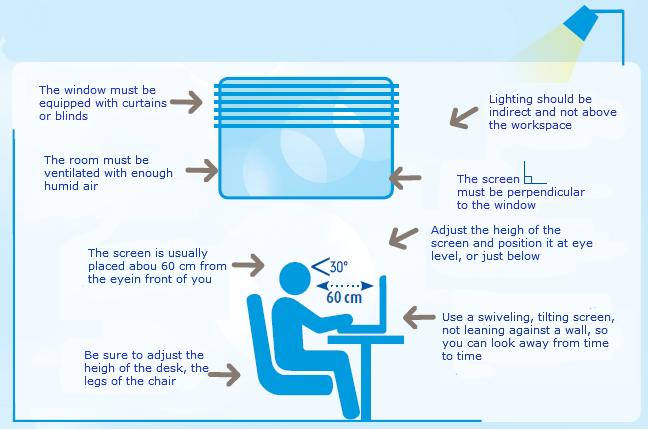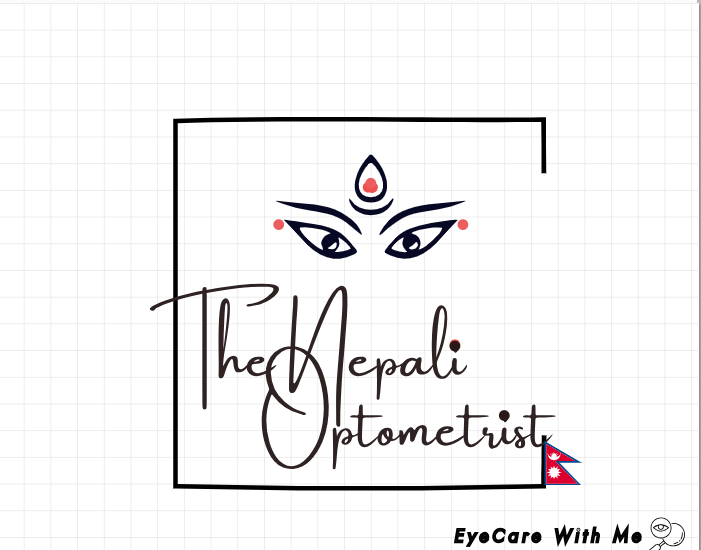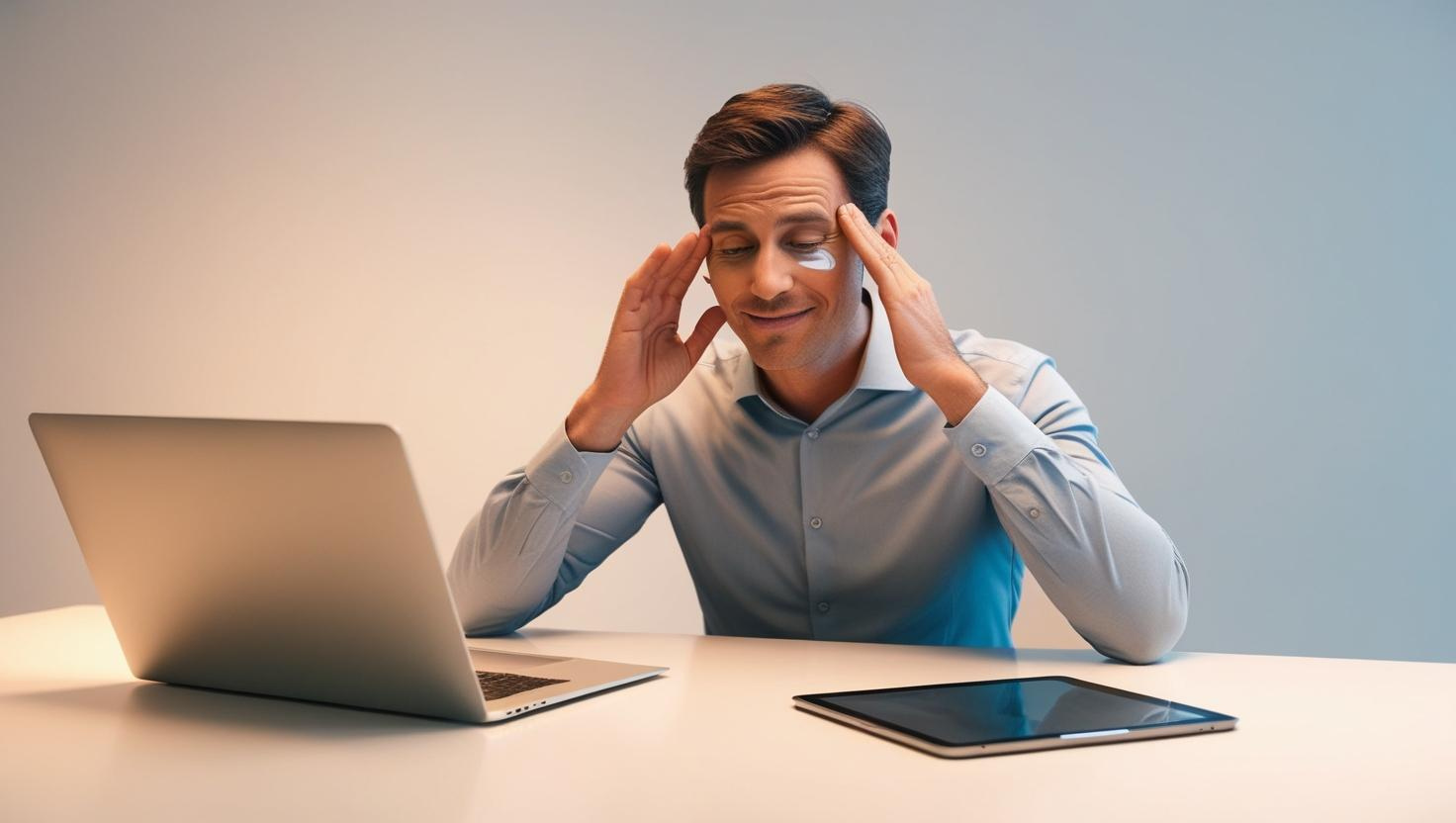Computer Vision Syndrome (CVS) also known as ‘Digital Eye Strain’ as described by the American Optometric Association is a group of vision and eye-related problems that occurs due to the overexposure of our eyes to digital screens. The most common symptoms of CVS include:
- Eye strain (eye ache, double vision, and difficulty focusing)
- Headache (often around the forehead and temples)
- Dry eyes (irritated and discomfort due to reduced blink rate)
- Neck and shoulder pain (usually due to poor posture and prolonged screen use)
DIGITAL DEVICES AND DRY EYES :
In this modernized era, almost every individual is working in front of laptops and computers and using mobile phones. The blink rate is generally 10-15 times per minute. Dry eyes due to prolonged use of digital screens, also known as computer vision syndrome (CVS) or digital eye strain, is a common issue in today’s digital age. Staring at screens for long periods can lead to reduced blinking, which causes tears to evaporate more quickly, resulting in dryness and discomfort
We normally think that our eyes have water (tears) but our eyes have oil and mucus inside them, which are being secreted. There’s a thin coat in front of the cornea called the Tearfilm, that moisturizes and lubricates our eyes. As there’s a decrease in the blink rate, the tear layer decreases causing Dry Eye Syndrome hence not providing nourishment and lubrication to the eyes. This will also lead to eye irritation and discomfort. As found by the studies, eventually the eyes may be vulnerable to infections.
How can we help it?
Staring at screens for extended periods can lead to reduced blinking, which causes tears to evaporate more quickly, resulting in dryness and discomfort. To treat dry eyes, first one must diagnose it carefully by a comprehensive eye examination and history taking. The patient’s blink rate and condition of the eyelid and cornea must be evaluated. Then, after proper refraction, the measurement of the quality and quantity of tears should be done thoroughly. Here are some strategies to help alleviate dry eyes associated with digital screen use:

©American Optometric Association[/caption]
- Follow the 20-20-20 rule: Every 20 minutes, take a 20-second break and look at something at least 20 feet away. This gives your eyes a chance to rest and helps reduce strain.
- Blink frequently: Remind yourself to blink more often while using digital devices. Blinking helps spread tears evenly over the surface of your eyes, keeping them moist.
- Adjust screen settings: Reduce the brightness and glare of your screen to minimize eye strain. Adjust the text size and contrast for better readability.
- Maintain proper lighting: Ensure that the lighting in your workspace is adequate and doesn’t cause glare on your screen. Avoid harsh overhead lighting and position your screen to minimize reflections.
- Use artificial tears: Over-the-counter lubricating eye drops can provide relief from dryness and irritation. Use them regularly, especially if you’re spending long hours in front of a screen.
- Stay hydrated: Drink plenty of water throughout the day to help keep your body and eyes hydrated. Dehydration can worsen dry eye symptoms.
- Take regular breaks: Give your eyes frequent breaks from screen time. Use these breaks to rest your eyes, blink, and focus on objects at varying distances.
- Consider computer glasses: Prescription or non-prescription computer glasses with anti-reflective coatings can reduce glare and minimize eye strain during prolonged screen use.
- Position your screen correctly: Ensure that your screen is positioned at eye level and at an appropriate distance (about arm’s length away) to reduce strain on your eyes and neck. Correcting sitting position and viewing distance.
- Use screen filters: Consider using screen filters or blue light-blocking glasses to reduce exposure to blue light, which can contribute to eye strain and disrupt sleep patterns.
Also,
- Adding tears: Usually, mild cases are treated using artificial tear drops. A preservative-free eye drop is preferable for long-term use.
- Increasing tear production: Increasing tear production by taking omega-3 fatty acids as a nutritional supplement may help.
- Conserving tears: Allowing our natural tears to stay in our eyes for a longer time can help our eyes stay moist.
- Reduce evaporation: Reduce room temperature with humidifiers.
- Treatment of lids like Blepharitis and lid hygiene is important. If any inflammation around the eyes, a warm compress or lid massage might help.
For CVS: Usually, improving the working condition in front of our screen can help ease our eye irritation and discomfort.

©Théa Laboratories[/caption]

